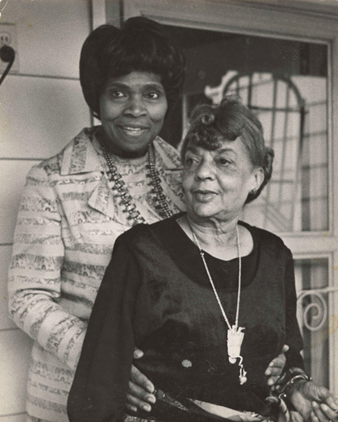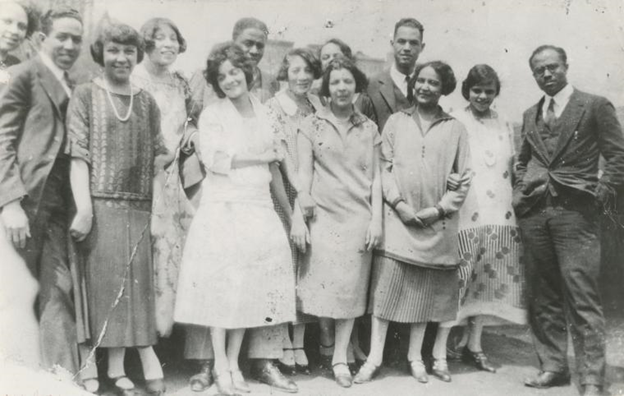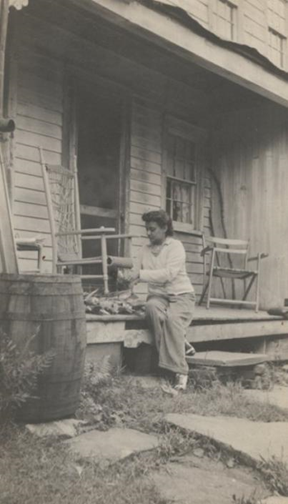Recovering Regina
News Based on facts, either observed and verified directly by the reporter, or reported and verified from knowledgeable sources.
The life and legacy of local playwright and librarian Regina Anderson Andrews are captured in a new biography that explores her contributions to the Harlem Renaissance.

Good morning! Today is Friday, November 12, and you are reading today’s section of Examiner+, a digital newsmagazine serving Westchester, Putnam, and the surrounding Hudson Valley.
Need to subscribe — or upgrade your Examiner+ subscription to enjoy full access to all of our premium digital content? Details here.

Regina Anderson Andrews (foreground) during a visit with famed African American contralto Marian Anderson at Andrews’ 34-acre Mahopac homestead. (Courtesy Ethelene Whitmire)
The life and legacy of former Mahopac resident Regina Anderson Andrews are thoughtfully unearthed in a new biography, Regina Anderson Andrews, Harlem Renaissance Librarian (University of Illinois Press, 2014).
Authored by Ethelene Whitmire, Professor and Department Chair of Afro-American Studies at the University of Wisconsin-Madison, the book details the pivotal role Andrews played in creating a local social network for her fellow artists and intellectuals at a time when Harlem was the mecca of Black American culture and social mobility. Whitmire felt compelled to tell Andrews’ story after discovering the impact and legacy of the people Andrews surrounded herself with during the after-hours salons she hosted as the first African American to head a branch of the New York Public Library. These figures, thanks to the cross-pollination of ideas and exposure that Andrews’ legendary salons fostered, would go on to become the most iconic Black minds of the modern era. Langston Hughes was a frequent visitor and W.E.B. Du Bois was her advocate in her own fight for racial justice within the New York Public Library system.
I caught up with Whitmire to learn more about the life and perspectives of this luminary, who, along with her husband William T. Anderson, an attorney and legal assistant to the NAACP, called the house on Long Pond Road home starting in 1940. Andrews passed away in 1993 and is buried with her husband in Putnam Valley’s Rosehill Cemetery.
EXAMINER+: For our readership, which covers Northern Westchester and Putnam counties, including Mahopac where the Andrews family would settle when they left New York City, can you briefly define the Harlem Renaissance and ground us in what time period this covers in American history?
ETHELENE WHITMIRE: Generally, the Harlem Renaissance happened in between the two World Wars. It is difficult to establish a specific timeline for this period, which consisted of a convergence of Black American writers, poets, visual artists, scholars, and activists in this New York City neighborhood. Most of the members of the Harlem Renaissance were what W. E. B. Du Bois called the Talented Tenth or Alain Locke called the New Negro — educated Black Americans who would hopefully uplift other members of the race through their art, leadership, and activism.
E+: Why was Andrews’ story, of all the stories you could’ve told from a period so ripe with luminaries, the one you felt called to document and preserve?
WHITMIRE: At the time I discovered Andrews’ story I was a professor in the field of library and information science and I was a former Librarian-in-Residence at Yale University. I knew that there was not a lot of Black American librarians in the 1920s when Andrews entered the profession and I was intrigued by her extracurricular activities — writing plays, acting in plays, participating in a civil rights organization (the National Urban League), and in a women’s organization (the National Council of Women of the United States), and traveling around the world and defying the stereotype of a spinster librarian with a nearly 58-year-old marriage and raising a daughter.
E+: Why do you think Regina attempted to self-identify as an American instead of Negro or colored initially? What does someone like Andrews teach us about the facts of racial identity vs. perceived racial identity vs cultural identity?
WHITMIRE: When Andrews applied for a job at the New York Public Library, the application most likely asked for an applicant’s nationality. As she said, she was an American. But as her interviewer told her, he did not consider someone who wasn’t white to be an American. But she probably knew that employers wanted applicants to say they were Negro or colored—in order to not hire them or to send them to the “colored” branch, and Andrews probably felt that her race was irrelevant—that her credentials were what was important to focus on.
E+: How did her feelings about her own racial identity change, if at all, as time went on?
WHITMIRE: While Andrews was aware of her racial identity growing up, it didn’t seem relevant until she started working at the New York Public Library. She told a friend about her life as a child and young adult in Normal, Illinois, where she had white classmates and she said, “We knew nothing of race and prejudice…those lessons have followed.” Her employment in the Chicago Public Library was based on her score on a civil service exam. Du Bois argued that the New York Public Library should use civil service exams too — the person with the highest score gets the next available job — regardless of race. She knew she was a Negro because her father was involved in race-related legal cases and her mother was a member of a Black women’s civic group. Andrews was very interested in what was going on in Harlem in terms of visual art, novels, poetry, activism. But her theater group, the Harlem Experimental Theatre, did not think that they should limit the plays they performed to race-related topics, although all three plays that she wrote were about race (the underground railroad, passing, and lynching).

Breakfast party for Langston Hughes hosted by Regina Andrews and Ethel Ray, Harlem, New York, 1925. Ethel Ray and Langston Hughes pictured first, left corner, back row. Regina Andrews pictured first, front row (Courtesy Schomburg Center for Research in Black Culture, Photographs and Prints Division, NYPL)
E+: What did you learn during the journey of writing this book that surprised you or that you still carry with you today?
WHITMIRE: I never studied Black American history in secondary or post-secondary schools and I was surprised to read about the rich history of Black Americans in the middle to upper-middle class and about unknown people, besides Andrews, like her father William G. Anderson — a Johnnie-Cochran-like figure in Chicago legal history and her father-in-law William Trent Andrews, Sr., a newspaper editor, lawyer, real estate mogul, and her own husband, who was a politician and lawyer and was Adam Clayton Powell Jr.’s most fierce opposition when he ran to be the first Black Congressman representing Harlem. It fueled my passion to tell untold stories — to do recovery work.
E+: In the movie, In The Heights, which takes place in Washington Heights where Andrews served as a librarian, the neighborhood grandmother stresses the importance of preserving one’s simple dignity as an immigrant in America. That phrase came to mind a lot as I was learning Regina’s story. Can you speak to how this ethos is at play too in the lives of Harlem strivers like Regina and her husband and peers?
WHITMIRE: Black Americans like Andrews and her peers were aware that many people looked down on them and they felt the need to look impeccable, have impeccable manners, have impeccable educational and professional credentials in order to hopefully combat racial prejudice. Sadly, this often made no difference when most people only saw the color of their skin. A lot of this was demonstrated in the rules about behavior and dress that Andrews encountered at Wilberforce University, but she also chafed under those restrictions too.
E+: Regina famously held salons in her Harlem apartment where she hosted such well-known icons of Black excellence as W.E.B. Du Bois and Marian Anderson, the famed black soprano who visited her in Mahopac. What did Andrews understand about community and conversation that we would be wise to remember today?
WHITMIRE: Andrews was a connector — she knew it was important to introduce people with similar interests to one another to help them flourish. She invited poets to read their work in salons and introduced readers to books with characters that looked like them and to see people on stages and in art that looked like them.

Andrews shucks corn on the front porch of her Mahopac home, 1940. (Courtesy Schomburg Center for Research in Black Culture, Photographs and Prints Division, NYPL)
E+: Can you provide any insight as to why the Andrewses chose Mahopac for their country home as opposed to towns closer to New York City with established enclaves of middle-class Black Americans like New Rochelle or Mount Vernon?
WHITMIRE: Andrews said the location was ideal, in between New York City where they lived and Albany, where her husband had to work — apparently there was a train that made the commute easy — when I went to Mahopac many years ago, I had to take a taxi to get to her home — as apparently, the train service was different from the 21st century. And, perhaps they were enchanted by the home or got a good price in 1941 for a 1799 New-England-style home on thirty-four acres. She said the house was in disrepair—the roof was caved in, the toilet was outside, the heat was from a coal stove. It was so different from their life in the city. Her husband planted a garden and she canned and did needlepoint.
E+: What would Regina be reading or recommending to us in 2021?
WHITMIRE: She would read all of the fiction by Black Americans and young African writers too and probably Black British writers. She was a prolific reader and liked to keep abreast of the latest novels.
Take a trip downstate and go Uptown to Harlem’s mecca of Black scholarship. The Schomburg Center for Research in Black Culture, where Andrews’ was once a librarian, currently maintains the collection of her priceless photography and papers. Hours: Tuesday-Saturday, 10 am-6 pm; CLOSED, Sunday/Monday.
If you can’t make it in person, here’s a link to the online Andrews collection, a great alternative to doom scrolling.
Ani Wilmot is a native of the Bronx and ex-pat of Westchester County. She gave up ambition for destiny because she could steal, but she could not rob. These days, she likes to work as little as possible, preferably in sight of a large body of water like the Hudson River. She covers hidden/lost histories of the Hudson Valley and American culture. Keep up with Ani’s adventures in reporting on the American wild here.
We hope you’ve enjoyed today’s section of Examiner+. We love honest feedback. Tell us what you think: examinerplus@theexaminernews.com

Examiner Media – Keeping you informed with professionally-reported local news, features, and sports coverage.
